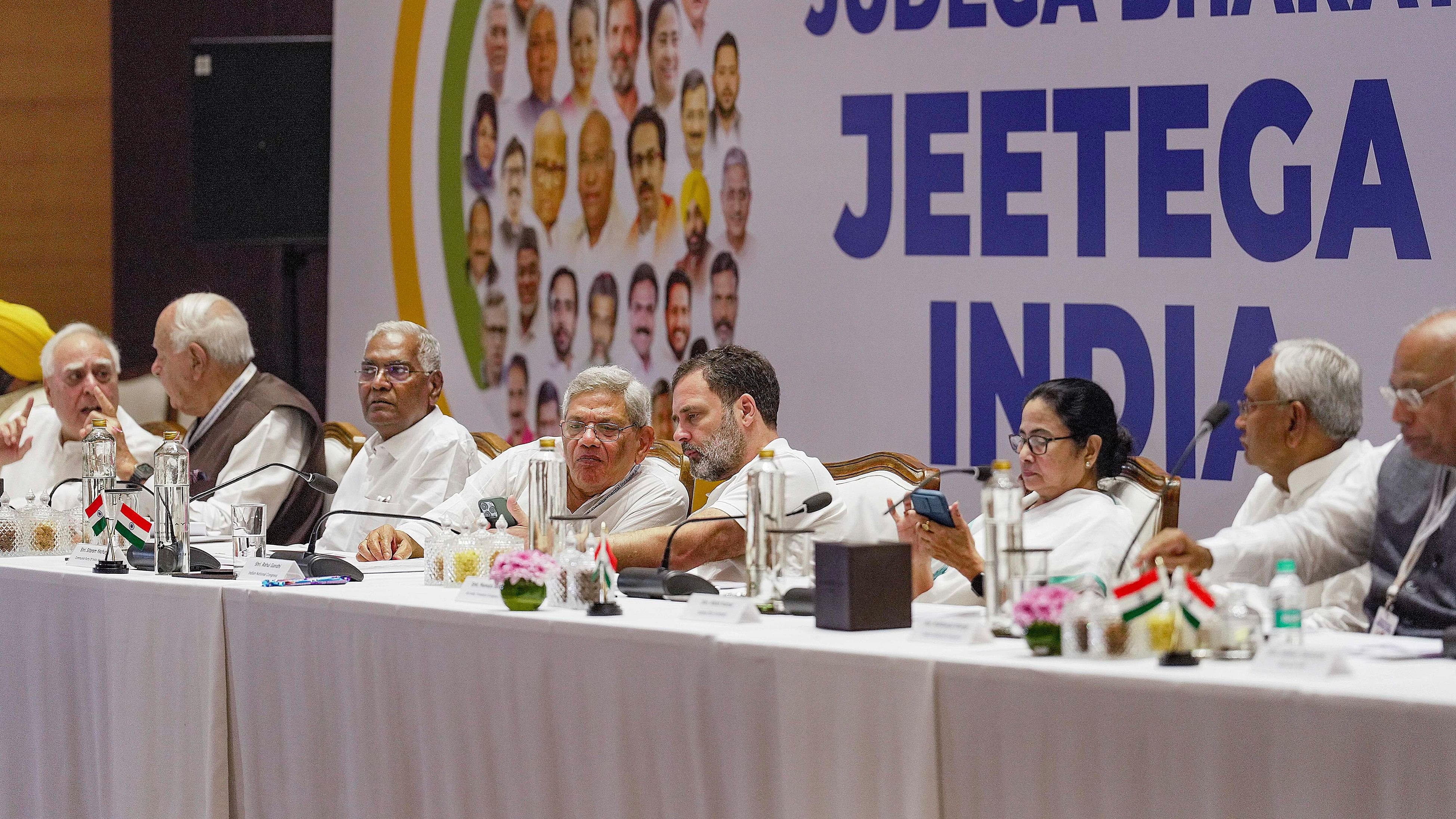
Congress leader Rahul Gandhi, CPI(M) General Secretary Sitaram Yechury, West Bengal CM and TMC supremo Mamata Banerjee, Bihar CM Nitish Kumar, Congress President Mallikarjun Kharge and other opposition leaders during the meeting of I.N.D.I.A in Mumbai.
Credit: PTI Photo
Will the Union government take a decision that will disorient the Opposition during the special session of Parliament, or will it be business as usual with posturing/posing by Prime Minister Narendra Modi? We do not know, but what we should know is that the Bharatiya Janata Party (BJP) understands the power of coalition formation better than other political forces. Therefore, it sees a clear threat in the structural potential of the I.N.D.I.A coalition, and is working overtime to control the narrative and create events that would inspire shock and awe.
The ruling BJP and sections of the media that are pro-government may mock the process of inimical forces getting together, but coalition formation was a staple practice of its predecessor, the Jana Sangh. Indeed, historically, it is the Hindu Right that always understood the importance of creating improbable alliances to corner a dominant party. The Jana Sangh, the earlier political wing of the Rashtriya Swayamsevak Sangh (RSS), was active in coalitions from the time it began to be forged against the Congress in 1967.
It was socialist ideologue Ram Manohar Lohia who explicitly advocated the coming together of parties of different ideologies to fight a common foe — he would coin the phrase ‘anti-Congressism’. Lohia died in 1967, the year when such alliances were formed after two decades of Congress hegemony. In sync with this thinking was the RSS/Jana Sangh.
That year, the Congress managed to come to power at the Centre with reduced numbers, but lost the government in many states. In some states, coalitions were forged between ideologically diverse parties — in Bihar, the regime included two socialist parties, the Communist Party of India (CPI) and the Jana Sangh. Similarly, the regime in Punjab combined the Akali groups, the communists, the socialists and again, the Jana Sangh.
Many such regimes did not last, and, hence, thereafter upsetting the cycle of simultaneous polls to the Centre and the states.
A decade later, in 1977, the Jana Sangh would again be a pivot of the coalition when it merged into the Janata Party (created to fight against Indira Gandhi when she lifted the Emergency and called for elections). The prominent bloc in that formation was again the socialists, but the Jana Sangh was also crucial. The Janata Party would defeat Gandhi but it collapsed under the weight of its contradictions.
It is after this coalition collapse that the BJP was founded in 1980 — and would get into the business of propping up alliances at the first opportunity.
Take the National Front government formed in 1989 by V P Singh. The National Front had 143 seats, less than the Congress’ 197, but was propped up by both the BJP and the Left parties giving outside support. This regime did not last long although the unleashing of forces of OBC mobilisation (referred to as Mandal) and the Ram mandir movement politics would subsequently transform Indian politics.
The year 1989 marked the end of the Congress hegemony, but till the 1999 prime ministership of Atal Bihari Vajpayee coalitions would fail due to their contradictions. There were two models of coalitions led by Vajpayee: a 1998 government that collapsed within a year was a post-poll gathering of parties that mustered a simple majority after giving letters of support (the AIADMK led by the late J Jayalalitha would withdraw). The 1999 Vajpayee-led coalition, the first to last a full five-year term, however, involved many pre-poll arrangements and seat sharing, such as I.N.D.I.A is now attempting.
The Modi-era BJP has reversed the RSS/Jana Sangh/BJP tradition of seeking allies. The undivided Shiv Sena, the Janata Dal of Nitish Kumar, and the Shiromani Akali Dal are the long-standing allies that have abandoned the BJP-led National Democratic Alliance (NDA) during the nine-year tenure of the current Prime Minister.
Therefore, it’s a mistake to see the BJP as supremely confident. On the contrary, it is seeking to bring about every structural change in the electoral process — such as the Bill that downgrades the position of the CEC (Chief Election Commissioner) and gives the government control over the appointment — to probably give itself every possible advantage in the general election.
I.N.D.I.A is better crafted than many political alliances in India. It has a galaxy of rooted and strong chief ministers, besides charismatic state/caste satraps in the mix. Together, they make a formidable bloc in terms of pure arithmetic. True, ‘anti-BJPism’ is the credo that brings the parties together as I.N.D.I.A is an act of both creation and desperation in an age where the Opposition faces the onslaught of enforcement agencies while political finance is dominated by the BJP. The constant sniping at the coalition from the ramparts of the BJP indicates that its leaders see a real challenge even if propaganda suggests otherwise.
(Saba Naqvi is a journalist and author.)
Disclaimer: The views expressed above are the author's own. They do not necessarily reflect the views of DH.